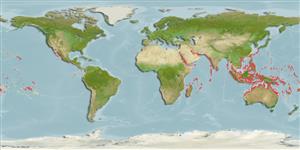Teleostei (teleosts) >
Gobiiformes (Gobies) >
Gobiidae (Gobies) > Gobiinae
Etymology: Gobiodon: Latin, gobius = gudgeon + Greek, odous = teeth (Ref. 45335).
More on author: Rüppell.
Environment: milieu / climate zone / depth range / distribution range
Ecology
Marine; reef-associated; depth range 0 - 20 m (Ref. 86942), usually 2 - 20 m (Ref. 27115). Tropical; 22°C - 27°C (Ref. 27115); 30°N - 30°S
Indo-West Pacific: Red Sea south to Delagoa Bay, Mozambique and east to Samoa, north to southern Japan, south to the Great Barrier Reef.
Size / Weight / Age
Maturity: Lm ? range ? - ? cm
Max length : 6.6 cm TL male/unsexed; (Ref. 9710)
Dorsal
spines
(total): 7;
Dorsal
soft rays
(total): 9-11;
Anal
spines: 1;
Anal
soft rays: 9. Characterized by having variable body color from yellow to yellowish green or black; presence of pair of blue bars through eye, second pair across back of head; blue stripe along base of dorsal fin; upper pectoral base with small dark spot (Ref. 90102).
Facultative air-breathing in the genus (Ref. 126274); Associated with colonies of broadly branched corals (Acropora spp.) (Ref. 35408); a coral-commensal species (Ref. 72446). Produces toxic mucus (Ref. 9360, 48637).Has been reared in captivity (Ref. 35408). Solitary or in pairs (Ref 90102). Feeds on small invertebrates and zooplanktons (Ref. 89972). Maximum depth from Ref. 027115.
Life cycle and mating behavior
Maturity | Reproduction | Spawning | Eggs | Fecundity | Larvae
Oviparous, demersal spawner (Ref. 101194).
Hoese, D.F., 1986. Gobiidae. p. 774-807. In M.M. Smith and P.C. Heemstra (eds.) Smiths' sea fishes. Springer-Verlag, Berlin. (Ref. 2798)
IUCN Red List Status (Ref. 130435)
Human uses
Aquarium: commercial
More information
ReferencesAquacultureAquaculture profileStrainsGeneticsElectrophoresesHeritabilityDiseasesProcessingNutrientsMass conversion
Tools
Special reports
Download XML
Internet sources
Estimates based on models
Preferred temperature (Ref.
123201): 24.7 - 29, mean 27.9 °C (based on 1134 cells).
Phylogenetic diversity index (Ref.
82804): PD
50 = 0.5000 [Uniqueness, from 0.5 = low to 2.0 = high].
Bayesian length-weight: a=0.01995 (0.00906 - 0.04395), b=3.01 (2.83 - 3.19), in cm total length, based on all LWR estimates for this body shape (Ref.
93245).
Trophic level (Ref.
69278): 3.3 ±0.6 se; based on diet studies.
Resilience (Ref.
120179): High, minimum population doubling time less than 15 months (Preliminary K or Fecundity.).
Fishing Vulnerability (Ref.
59153): Low vulnerability (10 of 100).
Nutrients (Ref.
124155): Calcium = 168 [73, 326] mg/100g; Iron = 0.923 [0.459, 1.839] mg/100g; Protein = 18 [16, 20] %; Omega3 = 0.12 [0.05, 0.23] g/100g; Selenium = 23 [11, 48] μg/100g; VitaminA = 89 [22, 361] μg/100g; Zinc = 1.95 [1.23, 3.03] mg/100g (wet weight);
